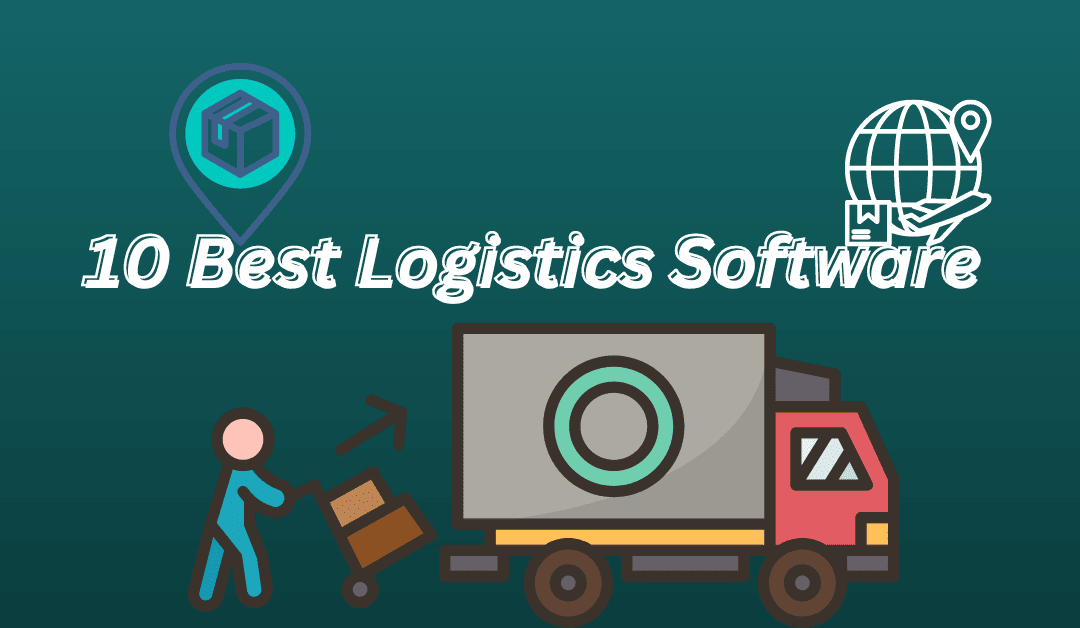Logistics software has evolved as a crucial tool for firms trying to optimize their operations in the ever-changing world of global commerce and supply chain management. This software has achieved new heights recently, spurred by technological improvements and a growing desire for efficient procedures.
Logistics software is a collection of digital solutions to help businesses manage different areas of their supply chains, such as inventory control, transportation, warehousing, and order fulfillment.
This software has become essential for companies of all sizes and sectors. It helps organizations to optimize routes, save transportation costs, track shipments in real-time, and precisely estimate demand. It also allows for smooth collaboration and communication across stakeholders such as suppliers, manufacturers, distributors, and retailers.
The advantages of logistics software are numerous. It enables organizations to simplify processes, cut inventory holding costs, increase customer satisfaction through on-time delivery, and adapt quickly to market shifts. Furthermore, logistics software is vital in encouraging sustainability and lowering carbon footprints by optimizing transit routes and decreasing waste.
As global trade becomes more complicated, the importance of logistics software in improving operational efficiency and driving corporate success cannot be emphasized. Logistics software is revolutionizing how items are carried, stored, and delivered using the power of new technology.
Top Three Pick:
Our three top picks for this software are listed below with unique features.
SAP Transportation Management: SAP TM is a prominent logistics software provider that offers complete insight and control over transportation operations. It enables businesses to make educated decisions and provide excellent customer service.
Oracle Transportation Management: Oracle TM is comprehensive logistics software noted for its flexibility and powerful capabilities. TM assists organizations in identifying opportunities for improvement, optimizing resource allocation, and increasing overall operational efficiency.
Descartes Logistics Management: Descartes is a renowned provider of logistics software solutions, and its Logistics Management Platform is notable for its ability to integrate seamlessly. It connects organizations to an extensive network of carriers, suppliers, and customers.
List of 10 Best Logistics Software
Choosing logistics software has several benefits and characteristics that make it an indispensable instrument for firms in today’s fast-paced and complicated supply chain landscape. Logistics software automates and simplifies activities, including inventory management, order fulfillment, and transportation planning.
It dramatically improves operational efficiency by reducing manual activities and giving real-time information. Businesses may save time and money by optimizing routes, lowering transportation expenses, and improving resource allocation.
Logistics software allows firms to manage shipments, check inventory levels, and obtain insights into performance indicators by providing end-to-end visibility into the supply chain. This visibility enables proactive decision-making, prompt interventions, and rapid problem resolution.
Logistics software is critical to satisfying consumer expectations. Choosing logistics software improves efficiency, visibility, customer happiness, scalability, flexibility, compliance, and risk management. The changing world of supply chain management enables firms to remain competitive, optimize operations, and drive development.
The most important thing is to find out what other people think about Logistics software. Read about the difficulties and flaws that other users have encountered when using the software. Check customer evaluations for remarkable features that should be included in paid editions, and look for hidden fees not mentioned in the documentation.
Expert Team have investigated free Logistics software, differentiating between good and bad software. The top ten Logistics software is listed below; I hope you discover the finest Logistics software for your company.
List Here:
1. SAP Transportation Management: SAP TM, well-known for its sophisticated optimization capabilities, enables firms to optimize routes and resources, lowering transportation costs and increasing efficiency.
2. Oracle Transportation Management: TM is distinguished by its sophisticated analytics capabilities, which enable organizations to get essential insights into supply chain performance and make data-driven decisions.
3. Descartes Logistics Management: Descartes Logistics Management connects organizations with an extensive network of carriers, suppliers, and customers, allowing for efficient collaboration and communication.
4. JDA Warehouse Management: JDA WMS provides better warehouse optimization, allowing organizations to maximize space utilization, reduce labor expenses, and increase inventory accuracy.
5. Manhattan Associates Warehouse Management System (WMS): Manhattan WMS specializes in providing complete visibility and control over warehouse operations, improving inventory accuracy, and enabling efficient order fulfillment.
6. BluJay Solutions Transportation Management: BluJay TMS enables end-to-end insight and cooperation across the transportation network, allowing for better decision-making, cost reduction, and improved customer service.
7. HighJump Warehouse Management System: HighJump WMS is well-known for its scalability, which enables organizations to respond to changing demands and easily extend their warehouse operations.
8. MercuryGate TMS: MercuryGate TMS is known for its powerful freight management features, which allow organizations to optimize carrier selection, prices, and routes, resulting in increased transportation efficiency.
9. 3Gtms TMS: 3Gtms TMS emphasizes flexibility that enables organizations to modify the software to their individual needs, adjusting to unique requirements and procedures.
10. Infor Supply Chain Management: Infor SCM distinguishes itself with its end-to-end supply chain visibility, which provides organizations with real-time insights into inventory levels, demand, and supply, allowing proactive decision-making and improving operational efficiency.
SAP Transportation Management
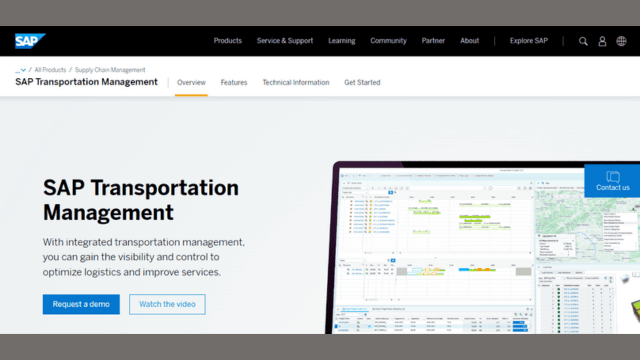
SAP Transportation Management (SAP TM) is a robust and comprehensive software solution that helps organizations of all sizes optimize and simplify their transportation operations. It provides end-to-end insight and control over the transportation process. And allow organizations to manage their logistics operations more effectively and increase customer satisfaction.
With its sophisticated features and capabilities, SAP TM has emerged as a top solution for businesses looking to improve their transportation management capabilities. SAP Transportation Management is a sophisticated solution for addressing the complex difficulties of company transportation management.
Features of SAP transport management:
Some of the unique features of this software are the following:
Increased Visibility
SAP TM gives organizations real-time visibility into the transportation network, enabling them to manage shipments, monitor inventory levels, and access essential performance data. This insight allows organizations to make educated decisions, detect and handle issues proactively, and assure the timely delivery of goods.
Effective Planning and implementation
The program has robust Planning and execution capabilities, allowing organizations to optimize transportation processes. It aids in route planning, load optimization, carrier selection, and load tendering, assuring resource efficiency and lowering transportation costs.
Collaboration and Connectivity
SAP TM enables seamless cooperation and connection among shippers, carriers, and other transportation network players. It facilitates better communication, data exchange, and collaboration, increasing efficiency, fewer mistakes, and improved overall performance.
Analytics and Reporting
SAP TM provides robust analytics and reporting tools that enable enterprises to get insight into transportation operations. It delivers extensive reports, dashboards, and key performance indicators, allowing organizations to monitor performance, spot trends, and make data-driven decisions to improve continuously.
The following are some pros and cons of this software:
Pros
- Improved visibility and control of transportation operations.
- Effective Planning and execution, with optimal resource utilization and cost reduction.
- Consistent coordination and connection throughout the transportation network.
- Features for ensuring regulatory compliance and risk management.
- Capabilities for robust analytics and reporting for data-driven decision-making.
- System integration for optimized end-to-end supply chain processes.
Cons
- Implementation and usage complexity and learning curve.
- Expensive initial investment and continuing upkeep.
- Customization constraints may necessitate further development work.
- The possibility of a system outage and technological problems interfering with operations.
Oracle Transportation Management
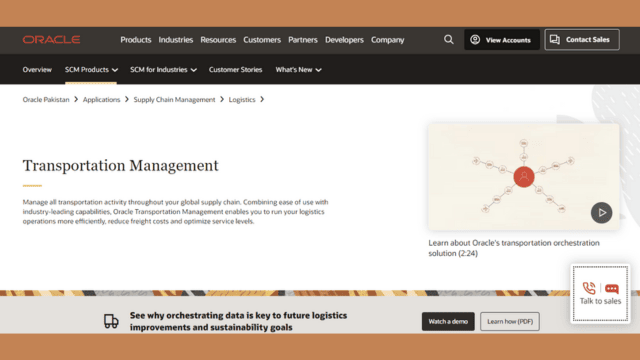
Oracle Transportation Management (OTM) is Oracle Corporation’s complete transportation and logistics management system. It is intended to assist organizations in streamlining transportation operations, optimizing logistics procedures, and improving overall supply chain efficiency.
OTM provides various features and capabilities, allowing organizations to plan, execute, and monitor their transportation activities successfully.
Critical features for oracle transport management
Some of the unique features of this software are the following:
End-to-End Visibility
OTM gives organizations real-time visibility into transportation operations, allowing them to track shipments, check delivery statuses, and resolve any possible difficulties. This visibility improves operational efficiency and allows for more informed decision-making.
Advanced Planning and Optimization
OTM’s sophisticated planning and optimization tools enable organizations to develop effective transportation plans that optimize routes, modes of transportation, and carrier selection. It considers various aspects such as prices, service levels, and restrictions to provide the best transport plans.
Freight Payment and Audit
OTM contains tools for automating goods payment and auditing. It aids in the streamlining of financial processes by precisely estimating transportation costs, confirming invoices, and assuring contractual compliance.
Analytics and Reporting
The technology provides complete analytics and reporting capabilities, enabling enterprises to get meaningful insights into their transportation operations. Users may access essential performance metrics, analyze trends, and produce reports to encourage continuous development and make educated business decisions.
Scalability and Flexibility
OTM is highly scalable and flexible to the changing requirements of enterprises of all sizes. It can manage complicated transportation networks and accommodate supply chain expansion and changes, assuring long-term usage and value. The following are some pros and cons of this software:
Pros:
- Improved visibility and control of transportation operations.
- Simplified stakeholder cooperation and communication.
- Processes for goods payment and auditing have been automated.
- Comprehensive analytics and reporting capabilities.
- Scalability and versatility to support business expansion.
Cons:
- A complex implementation and integration procedure.
- Expensive initial outlay and recurring maintenance expenditures.
- Users who are inexperienced with the system face a steep learning curve.
Descartes Logistics Management

Descartes Logistics Management provides an all-in-one software solution developed to simplify and improve complicated logistics and supply chain management procedures. This revolutionary platform, created by the Descartes Systems Group, a global pioneer in logistics technology, enables organizations to boost their operational effectiveness.
Due to its broad capabilities and simple-to-use interface, Descartes Logistics Management provides a robust and adaptable solution for organizations, including sectors.
This platform’s robust features, including complete visibility, manner optimization, storage and transport leadership, statistical analysis, and connectivity capacity, allow organizations to simplify procedures, minimize expenses, and deliver exceptional customer service in today’s highly competitive marketplace.
Critical Features For Descartes’s Logistic Management
Some of the unique features of this software are the following:
Route Optimization
The program includes efficient algorithms that optimize the Planning of routes and load consolidation, which leads to quicker shipment and lower expenses for transport. Descartes Logistics Management assists firms in making educated choices to optimize their supply chain operations by considering aspects such as traffic patterns, truck capability, and shipping priority.
Warehouse Management
The software features complete warehouse administration skills, allowing organizations to handle inventories effectively, track stock movements, and optimize warehouse architecture. Organizations may expedite their warehouse procedures while improving inventory accuracy by utilizing technologies that include bin position management, automated picking, and counting cycles.
Carrier Management
Descartes Logistics Management enables smooth carrier collaboration by offering a centralized platform for managing carrier contracts, prices, and performance. The system allows for automatic carrier decision-making, shipping, auditing, and invoice reconciliation, ensuring correct invoicing and effective carrier management. The following are some pros and cons of this software:
Pros
- Greater accessibility and immediate time shipment tracking.
- Smart path optimization for faster delivery and lower costs.
- Integrated warehouse management capabilities for improved efficiency.
- Centralized carrier management and cooperation platform.
- Comprehensive analytics and reporting tools for data-driven decision-making.
- Integrated with current enterprise systems and external partners.
Cons
- Expensive starting points and modifications.
- A lengthy learning process awaits novice users.
- Few customization possibilities for individual company requirements.
- The possibility of relying on third-party integrations for particular features or functionalities.
JDA Warehouse Management
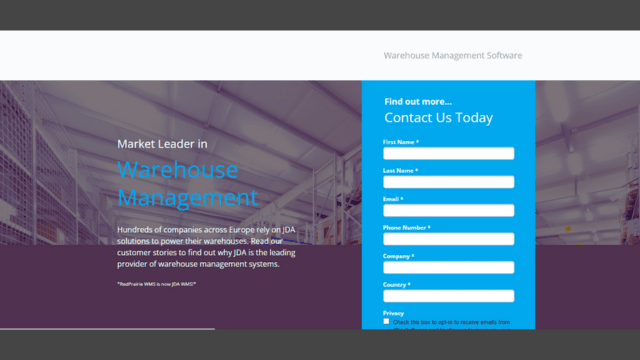
JDA Warehouse Management, sometimes called JDA WMS, is an effective software program to facilitate and improve warehouse operations. It is a top warehouse management system created by JDA Software that businesses from various sectors use to increase productivity, accuracy, and visibility in their distribution centers.
It helps organizations increase productivity, cut expenses, and provide superior customer service with inventory optimization, order fulfillment, warehouse control, labor management, and reporting capabilities.
Critical Features for JDA Warehouse Management
Some of the unique features of this software are the following:
Inventory Optimization
Businesses can precisely measure, monitor, and control their inventory levels thanks to the robust inventory management features offered by JDA WMS. It gives businesses real-time access to stock levels, enabling them to optimize inventory investments, cut transportation expenses, and lessen shortages.
Order Fulfillment
JDA WMS enhances order accuracy and speed with its sophisticated order management tools. From order reception to dispatch, it simplifies the order fulfillment process while streamlining the selection, packaging, and delivery procedures. It improves client happiness, decreases processing times, and higher order reliability.
Labor Management
Organizations can effectively oversee their personnel in the warehouse thanks to the software’s labor management features. It helps labor organize and allocate time while providing insights into labor efficiency and tracking productivity. It improves operational efficiency, reduces overtime expenses, and optimizes labor use.
Reporting and Analytics
JDA WMS provides organizations with valuable insights into warehouse operations through its extensive reporting and analytics tools. It creates thorough reports on key performance indicators (KPIs), enabling users to keep track of progress, spot potential problems, and decide on decisions based on data to streamline warehouse operations. The following are some pros and cons of this software:
Pros
- Improves inventory control and lowers carrying expenses.
- Simplifies order fulfillment procedures, increasing precision and quickness.
- Improves operational effectiveness and comprehensive warehouse security.
- Allows for efficient labor management, which boosts production.
- Offers extensive analytics and reporting capabilities for making decisions based on data.
Cons
- Complex customization and integration might present difficulties for some organizations.
- Initial implementation and setup may demand substantial time and resources.
- For smaller enterprises, the cost of upkeep and licensing may be prohibitive.
Manhattan Associates Warehouse Management System (WMS)

The Warehouse Management System (WMS) from Manhattan Associates is a top software product for streamlining and automating warehouse operations. Manhattan WMS helps organizations increase productivity, accuracy, and visibility within their distribution centers thanks to its extensive features and cutting-edge capabilities.
It is a reliable solution that enables companies to optimize their supply chain operations and is trusted by organizations globally. Manhattan WMS allows businesses to optimize inventory, cut costs, boost productivity, and provide better customer service thanks to its order fulfillment, warehouse control, labor management, and reporting features.
Critical features for Manhattan associates WMS
Some of the unique features of this software are the following:
Inventory Optimization
The comprehensive inventory management capabilities provided by Manhattan WMS so Businesses can optimize inventory holdings, save carrying costs, and lessen stock outs thanks to its real-time visibility into stock levels. The system uses sophisticated algorithms to choose the best inventory distribution replenishment plans and stock levels.
Order Fulfillment
From order reception to dispatch, the platform optimizes the order fulfillment process. It streamlines selection, packaging, and shipping processes, enhancing the precision of orders, cutting down on process lengths, and raising the satisfaction of consumers.
Labor Management
To efficiently manage the staff in the warehouse, the program has labor management features. It supports labor planning and scheduling while tracking labor performance and productivity. Manhattan WMS helps organizations optimize personnel numbers and cut overtime expenses by giving them access to labor utilization.
Reporting and Analytics
Robust reporting and analytics options are available with Manhattan WMS. It produces thorough reports on key performance indicators (KPIs) and offers current information on warehouse operations. Companies can track progress and pinpoint areas for development thanks to these statistics. The following are some pros and cons of this software:
Pros:
- Advanced optimization and inventory management tools.
- Complete warehouse management and improved operational effectiveness.
- Skilled labor management for the best possible worker use.
- Solid reporting and analytics for making decisions based on data.
- Scalable and flexible solution to accommodate expanding organizations.
Cons:
- Exorbitant setup and first costs for implementation.
- Demands for intricate customization and integration.
- A challenging learning curve for those who are new to the system.
- Needs continual instruction and assistance for efficient use.
BluJay Solutions Transportation Management
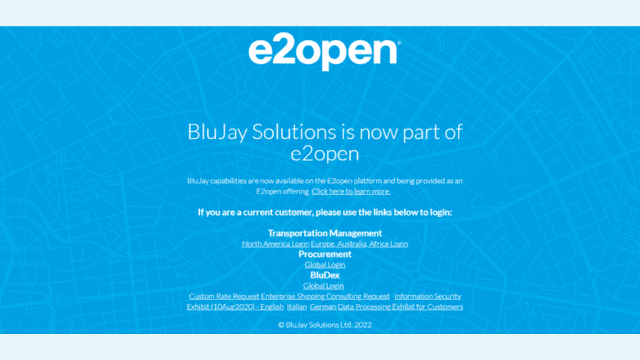
Leading supply chain software and services supplier BluJay Solutions provides cutting-edge approaches to streamlining and enhancing transportation operations. With the help of their Transportation Management system, which gives companies better visibility, control, and efficiency throughout their transportation networks, organizations may be empowered to thrive in logistics.
The Transportation Management solution from BluJay gives businesses a robust collection of features and capabilities to manage their end-to-end transportation operations and provide better client experiences.
Key features for BluJay Solutions’ Transportation Management
Some of the unique features of this software are the following:
Advanced Visibility:
The transportation management system from BluJay provides comprehensive insight across the
Whole transportation lifecycle. Businesses can trace the transit of products at every stage thanks to its real-time shipping monitoring. Swiftly identifying and rectifying delays or interruptions allows for proactive decision-making, assuring on-time delivery and higher customer satisfaction.
Centralized Control:
The system offers a single platform for controlling all transportation-related operations. Multiple carriers, modes, and geographical locations may be efficiently planned, carried out, and monitored by users. Complex logistical processes are made simpler, resource allocation is optimized, and operational effectiveness is increased thanks to this centralized control.
Carrier Management:
Effective career management is made possible by BluJay’s Transportation Management, which streamlines communication with preferred carriers and automates the carrier selection process. The technology assesses carrier performance based on established indicators, enabling businesses to pick pages wisely and bargain advantageous contracts.
Optimization Capabilities:
To simplify transportation arrangements and execution, the system uses robust optimization methods. It considers cargo volumes, delivery restrictions, carrier capacity, and service level needs to create the best possible shipping plans. The following are some pros and cons of this software:
Pros:
- Enhanced real-time tracking and visibility for better shipping monitoring.
- Simplified and centralized administration of transportation-related operations.
- Effective carrier coordination and cooperation with chosen carriers.
- Capabilities for optimization to save costs and improve operational effectiveness.
- Comprehensive instruments for guaranteeing regulatory compliance in international trade.
- A competitive edge derived from cutting-edge technology and innovation.
Cons:
- Beginning preparation along with execution might take some time and money.
- Staff receiving orientation and instruction to make the most of the system.
- Potential problems with integrating new software or systems.
- Budgetary concerns since more expensive features and capabilities may be available.
HighJump Warehouse Management System
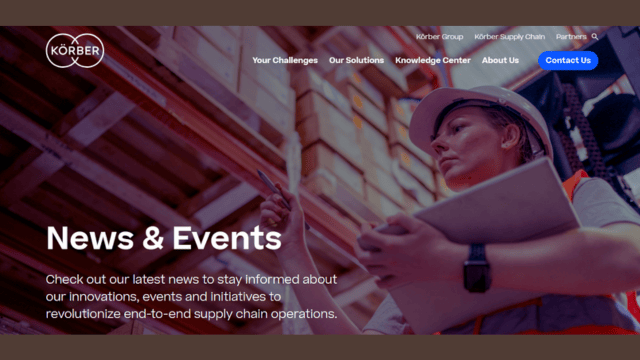
Modern software called the HighJump Warehouse Management System (WMS) is created to optimize and streamline the administration of warehouses. It provides many features and functions that help companies manage inventory more effectively, optimize order fulfillment procedures, and boost overall productivity.
HighJump WMS provides real-time visibility, control, and optimization across the supply chain using cutting-edge technology and clever algorithms.
Key features for HighJump Warehouse Management System
Some of the unique features of this software are the following:
Scalability and elasticity
Due to its excellent scalability, HighJump WMS is appropriate for companies of all sizes, from micro businesses to global conglomerates. It might grow with the business to accommodate growing order volumes, broadened product lines, and more warehouses or distribution centers. It can also adapt to changing company demands.
Well-organized Order accomplishment
HighJump WMS automates activities, including placing orders, gathering packaging, and shipping to expedite order fulfillment procedures. It speeds up order processing times, minimizes mistakes, and optimizes warehouse procedures. To increase overall productivity and satisfaction with clients, the system can automatically prioritize orders, assign inventory, and provide optimized selection methods.
Highly developed Tracking and Traceability
Advanced tracking and traceability features are built into HighJump WMS. Every good is given a unique identification number, allowing for accurate monitoring of its transit throughout the supply chain. In addition to improving inventory accuracy, this also makes it easier to comply with business regulations and, if an inventory recall is necessary, to handle it effectively.
Analytics and Reporting
With the powerful reports and analytics offered by HighJump WMS, organizations may learn essential details about the operation of their warehouses, inventory trends, order accuracy, and other areas. Users may monitor key performance indicators (KPIs), spot obstructions, and make informed decisions to optimize warehouse operations using configurable reports and graphs. The following are some pros and cons of this software:
Pros
- Flexible and adaptable for all sizes of enterprises.
- Visibility of the inventory in immediate time for precise inventory control.
- Processes for fulfilling orders have been streamlined to improve efficiency.
- Full end-to-end visibility through seamless connection with other enterprise platforms.
- Solid analytics and reporting for making decisions based on facts.
Cons
- Employees received orientation and instruction to make the most of the system.
- Potential problems with older systems being integrated.
- Constant upkeep and updates to keep the system current.
MercuryGate TMS (Transportation Management System)
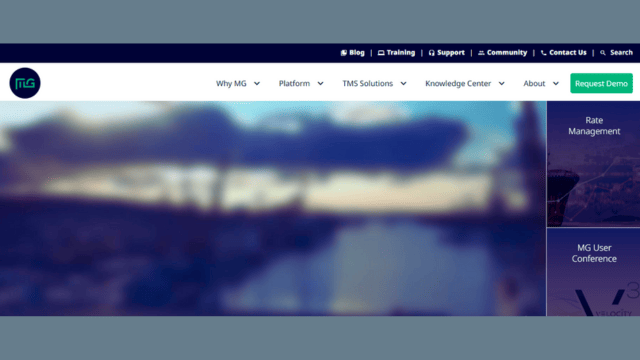
A state-of-the-art logistics management program called MercuryGate TMS was created to help firms streamline and improve their transportation operations. MercuryGate TMS is a complete suite of features and solutions designed by MercuryGate International, a top provider of transportation management software, to assist businesses in managing the flow of supplies efficiently, cutting costs, increasing efficiency, and improving customer satisfaction.
MercuryGate TMS has established itself as a top option for businesses looking to revolutionize their shipping management procedures because of its powerful features and user-friendly interface.
Key features for MercuryGate TMS (Transportation Management System)
A few of the unique features of this software are the following:
Scalability and Flexibility
Businesses may adopt their demands using MercuryGate TMS regardless of size or industry. It can scale smoothly from tiny, single-location companies to massive, global corporations, allowing you to adjust and expand as your business does.
Proficient Carrier Management
Rate negotiation, carrier selection, and performance monitoring are just a few of the powerful capabilities that MercuryGate TMS offers for managing carriers. Businesses can guarantee they deal with the most dependable and affordable pages by optimizing carrier partnerships and utilizing data-driven insights, increasing the overall efficiency of transport.
Optimization and Planning
Users may design effective transportation plans using the system’s potent optimization algorithms while considering expenses, speed, and capacity limits. Utilizing resources more effectively while lowering expenditures for transportation and unfilled mile counts is made possible by this feature.
Collaboration and Communication
All supply chain participants, including carriers, shippers, suppliers, and customers, can communicate quickly, thanks to MercuryGate TMS. The technology allows real-time data sharing and sending automatic notifications and interactive dashboards to keep everyone updated and engaged. The following are some pros and cons of this software:
Pros
- Customizable and flexible solution for companies of all sizes.
- Offers continuous monitoring and complete oversight of shipments.
- Tools for effective carrier management and optimization.
- Encourages interaction and cooperation among supply chain participants.
Cons
- There can be a learning curve for new users with specific complex capabilities
- Initial installation and setup may take time and resources.
- For best use, further training and assistance may be required.
3Gtms TMS

Innovative solutions that optimize and streamline transportation operations are available from 3Gtms, a top Transportation Management System (TMS) software provider, for businesses of all sizes and in various sectors.
Their TMS is created to handle the complicated issues that shippers, carriers, and logistics service providers confront, giving them the tools they need to improve the visibility of their supply chains, authority, and productivity.
Key features for EGtms TMS
Some of the unique features of this software are the following:
Advanced Visibility and Tracking
With real-time access into the logistics lifecycle offered by 3Gtms TMS, users can follow shipments, keep track of carrier performance, and spot possible hiccups. Companies may proactively solve problems, optimize pathways, and make intelligent choices to increase productivity and customer happiness with complete insight.
Flexible and Scalable Architecture
The TMS provided by 3Gtms is designed on a scalable and adaptable architecture to accommodate the particular requirements of various enterprises. The 3Gtms TMS can adapt to shifting demands and expand together with the firm, regardless of whether an organization needs a straightforward transportation management solution or a more intricate system with numerous interfaces.
Robust Optimization and Automation
The 3Gtms TMS automates and streamlines transportation planning procedures using robust algorithms and optimization capabilities. It considers several variables to provide the best routes and load plans, including delivery openings, carrier restrictions, and cost levels.
By automating certain operations, companies may decrease human mistakes, improve resource utilization, and generate lower expenses.
Collaboration and Communication
All parties engaged in the transportation process may collaborate and communicate, thanks to the TMS. Proactive notifications, status updates, and document sharing provide seamless communication among shippers, carriers, and customers. Improved interaction results in a better way. The following are some pros and cons of this software:
Pros
- Integrated transport management solution for complete visibility and administration.
- Effective Planning of routes and optimization for savings in both money and time.
- Automated carrier management and freight tenders for greater effectiveness.
- Package tracking and oversight in real-time for better customer service.
- Data change that is smooth thanks to integration with other systems.
Cons
- The initial implementation and training process could take some time and money.
- Difficulty integrating with current facilities and outdated systems.
- The potential for staff resistance to adjusting to new procedures.
Infor Supply Chain Management

The complete software system, Infor Supply Chain Management (SCM), was created to optimize and simplify the intricate procedures involved in supply chain management. It is an effective technology that gives companies visibility into the whole supply chain, from sourcing and procurement through manufacturing, distribution, and customer support.
Infor SCM uses modern innovations like predictive analytics, machine learning, and artificial intelligence to provide actionable insights and facilitate data-driven choices. Infor SCM helps organizations to improve operational performance, save costs, manage risks, and satisfy the constantly changing needs of the global marketplace thanks to its powerful features and capabilities.
Key features for Infor supply chain management
Some of the unique features of this site software are the following:
End-to-end visibility
With real access to the supply chain provided by Infor SCM, organizations can easily maintain inventories, monitor their production status, and handle logistics. This transparency promotes proactive choices and assists in quickly identifying and resolving bottlenecks or disturbances.
Demand planning and the fore
Programs provide sophisticated demand planning and forecasting tools that provide accurate demand predictions using historical data, industry trends, and mathematical models. This aids businesses in increasing customer happiness stock-outs stock-outs and optimizing inventory levels.
Supplier collaboration
By offering a centralized communication, document sharing, and performance monitoring platform, Infor SCM makes collaborating with suppliers easier. The procurement procedure is streamlined, on-time delivery of products and services is guaranteed, and solid supplier relationships are fostered.
Warehouse and inventory management
The system effectively administers warehouses and inventories by maximizing space utilization, automating replenishment procedures, and incorporating barcode scanning and RFID technology. It increases order fulfillment, lowers carrying costs, and improves inventory precision.
Transportation management
Robust transportation management features are provided by Infor SCM, covering freight auditing, load planning, carrier selection, and route optimization. Organizations can reduce shipping expenses, speed up deliveries, and increase the efficiency of logistics overall with the aid of these characteristics. The following are some pros and cons of this software:
Pros
- Increased supply chain visibility and openness.
- Improved capacity for demand planning and inventory management.
- Simplified procurement procedures to save costs.
- Effective management of delivery and order fulfillment.
- Real-time data analytics to aid in making wise decisions.
- Scalable and flexible solution to accommodate changing company requirements.
Cons
- Difficulties in the first integration and deployment.
- Potential employee opposition to implementing new procedures.
- Reliance on accurate and on-time information entry for optimum performance.
- Licensing, customization, and upkeep expenses.
Buying Guide for Logistics Software
Choosing the correct logistic software is essential for businesses to optimize their supply chain operations, increase productivity, and raise customer happiness. Making an informed choice requires taking several numbers of elements given the market’s abundance of possibilities. This buying guide thoroughly overviews the essential factors when choosing logistic software for your business.
Evaluate Your Business Needs:
Analyze your business needs, operational issues, and objectives before starting the buying process. Consider elements like the size of your operations, the number of shipments, inventory management, warehouse management, and any particular demands relating to your business.
Integration Capabilities
Examine the logistic software’s interoperability and integration capabilities with your current systems, including customer relationship management (CRM) tools, enterprise resource planning (ERP) software, and other company applications. Smooth data flow and the elimination of manual data entry promote seamless integration, which lowers mistake rates and boosts operational effectiveness.
Flexibility and scalability
To allow for future business development:
1. Consider the software’s scalability.
2. Inspect the software to ensure it can manage rising cargo quantities, accommodate several warehouses or distribution centers, and adjust to shifting company requirements.
3. Look for flexibility regarding customization possibilities and modular elements that may be adjusted to your unique needs.
User Experience and Usability
Choose logistic software with a simple user interface (UI) to use and comprehend. Your workers should only need minimal training programs to provide access and control while on the road; you must also check for mobile compatibility.
Vendor Support and Reliability:
Check out the software vendor’s credibility and reputation. Select a provider with a STRONG reputation and track record in logistics. To determine customer happiness, read reviews and testimonials from previous clients. Ensure the provider provides dependable technical assistance, frequent software upgrades, and help with implementation and training.
Frequently Asked Questions
Q: What does logistics software entail?
A: Software for managing the movement of resources, information, and items within a supply chain is referred to as logistics software. It includes computer programs and applications meant to expedite and optimize these operations. It aids businesses in effectively managing duties, including order monitoring, Planning for transport, inventory management, and warehouse operations.
Q: What advantages come with utilizing logistics software?
A: Logistics software may boost operational effectiveness, improve inventory management, expand supply chain accessibility, improve customer service, lower costs, and expedite order fulfillment, among other advantages. It facilitates efficient decision-making, automates laborious operations, reduces mistake rates, and offers real-time data insights.
Q: What distinguishing qualities does logistics software have?
A: Features including managing orders, control over inventory, transport management, administration of warehouses, chain of custody visibility, analytical and reporting, integration capabilities, and collaboration tools are frequently found in logistics software. These characteristics allow organizations to successfully plan, carry out, and monitor their logistics operations.
Q: Software for logistics: Is it appropriate for small businesses?
A: Even small and medium-sized firms (SMEs) may benefit from using logistics software. It may help small firms cut expenses, enhance customer happiness, and optimize their supply chain procedures. Solutions for logistics software are available that are tailored to small organizations’ requirements and financial constraints.
Q: What kinds of software are there for logistics?
A: There are many different kinds of logistics software on the market. Supply chain management systems (SCMS), inventory management systems (IMS), order management systems (OMS), and warehouse management systems (WMS) are a few examples of prevalent kinds. Each kind is concentrated on a particular element of logistical operations.
Q: Do current business systems and logistical software integrate?
A: Yes, current company systems like accounting software, customer relationship management (CRM) systems, and enterprise resource planning (ERP) systems may all be integrated with logistics software. Integrating several systems enables smooth data transmission, removing the need for manual data entry and guaranteeing accurate and current information throughout the organization.
Q: How can supply chain visibility increase thanks to logistics software?
A: Logistics software gathers and analyzes data from numerous sources, including transportation companies, warehouses, and vendors, to offer real-time visibility into the supply chain. It enables businesses to keep tabs on inventory levels, track shipments’ progress, and spot any possible delays or bottlenecks. This insight allows for proactive decision-making and aids businesses in promptly adapting to changes or supply chain interruptions.
Q: Can software for logistics aid in global logistics?
A: By offering capabilities like freight forwarding, compliance management, customs documentation, and foreign shipment tracking, logistics software may help with international logistics. It aids businesses in navigating the challenges of international trade, guaranteeing seamless cross-border operations and adherence to laws from other countries.
Q: Is software for logistics scalable?
A: Many logistics software options are scalable, adapting to an organization’s expanding demands. Businesses may quickly scale up the software to accommodate higher transaction volumes, more users, and new functions as their logistics operations grow or change.
Q: Software for logistics is secure, right?
A: Logistics software vendors are aware of the significance of data security and take precautions to safeguard confidential data. It involves adhering to industry standards, best practices, access limits, frequent backups, and encryption. It is crucial to pick a reliable software vendor who prioritizes data protection and provides advanced security measures.
Q: Can remote access be made to logistics software?
A: Numerous logistics software programs are cloud-based, allowing users to check in from anywhere with an internet connection. This remote accessibility encourages teamwork, allows for real-time updates, and lets companies manage their logistical operations even when employees are spread out across multiple regions.
Q: How long does it take to put logistics software into place?
Several variables, such as the programmer’s complexity, the organization’s size, the degree of customization needed, and the organization’s preparedness to accept the new system, influence.
How much time does it take to download logistics software?
Q: What are some typical difficulties encountered while implementing logistics software?
A: Several typical difficulties might arise while implementing logistics software. First, compatibility and data integration challenges may occur when combining the program with current systems or other platforms. Second, user adoption and training represent significant obstacles. Training logistics staff on the features and procedures of new software is frequently necessary before introducing it to them.
Q: How can I ensure the switch from manual to software-based logistical procedures goes smoothly?
A: Keep in mind these crucial elements to enable a successful transition from manual procedures to logistics software:
- Specify what you need.
- Do your homework and pick the best program.
- Plan and prepare
- Give instruction and assistance
- Test and pilot
- Gradually implement
- Watch and evaluate, and continuously improve.
Q: What possible challenges exist when integrating logistics software with current systems?
A: There are several possible challenges that organizations should take into account when integrating logistics software with current systems. The interoperability of the logistics software with the current systems is a significant obstacle. Data transport and synchronization provide another challenge.
Q: What are the most frequent mistakes or flaws in logistics software, and how can they be fixed?
A: Using logistics software may result in several typical mistakes or faults. Data entry mistakes, wherein inaccurate or incomplete information is inputted into the system, are one frequent problem. It may result in improper computations, incorrect interpretation of the facts, and erroneous decisions
Conclusion
In conclusion, logistics software has become an essential tool for enterprises in today’s complicated and quickly evolving world of global commerce and supply chain management. Due to technological improvements and an increasing need for efficiency, logistics software has been developed to offer total digital solutions for managing many areas of the supply chain, including inventory control, transportation, storage, and order fulfillment.
Out of the top ten logistics services listed above, SAP Transportation Management, Oracle Transportation Management, and Descartes Logistics Management are the finest three since they each have distinctive features and advantages. By giving businesses total visibility and control over transportation operations, SAP TM stands out and enables them to make wise decisions and provide top-notch customer service.
Also, logistics software makes it simple for stakeholders, including suppliers, manufacturers, distributors, and retailers, to collaborate and communicate. It links organizations to a vast network of carriers, suppliers, and customers to enable effective coordination and improve visibility throughout the supply chain. Due to the proactive actions and quick problem-solving made possible by this visibility, operational performance has improved.
The capacity of logistics software to enhance sustainability and lower carbon footprints is one of its main advantages. Organizations may help protect the environment by streamlining waste management processes and improving transportation routes. The software is essential for promoting ethical behavior and aligning firms with sustainability objectives.
Next Article > Billing Software For Small Business

